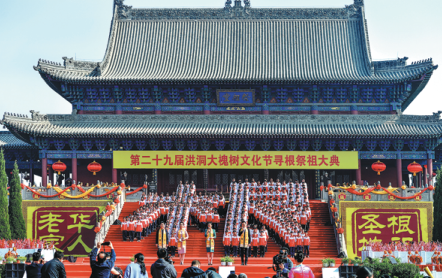Ancestral homeland where Chinese honor relatives
Updated: 2020-04-03

The 29th Dahuaishu Ancestor Worship Ceremony is held during Qingming Festival in 2019. [Photo by Chi Jianping for China Daily]
Qingming Festival-or Tomb Sweeping Day-celebrated in early April is a time for Chinese people to pay tribute to their ancestors and remember their deceased family members.
During this period, the township of Dahuaishu in Hongtong county, Shanxi province, is one of the most visited places in China. It is regarded as the ancestral homeland by many Chinese people.
Dahuaishu, which literally means the Big Locust Tree, is the place where many Chinese people inside and outside the country believe their ancestors started their long trek of immigration during the Ming Dynasty (1368-1644).
The Dahuaishu Ancestor Memorial Garden in Hongtong county, is a holy place for many Chinese people across the world.
Each year, thousands of Chinese return from afar during Tomb Sweeping Day to pay homage and show respect to their ancestors.
The garden has held the Dahuaishu Ancestor Worship Ceremony every April over the past three decades to welcome Chinese people who wanted to seek their ancestral roots there.
"If it were not for the novel coronavirus epidemic, we should have celebrated the 30th session of the ceremony this year," said Shi Ximin, an official of the memorial garden.
He said large celebrations on the site were canceled this year. However, the ancestor worship ceremony will still be held online.
"The policy was made to avoid crowding during this special period of time," Shi said.
The official said the ceremony will not be short of any necessary rituals, which will be performed by staff members of the garden and broadcast live.
"Qingming Festival-with a history of more than 2,500 years-is one of the most popular festivals in China as Chinese people highly value ancestral roots and familial piety," said Niu Xiaomin, a researcher of folk cultures in Shanxi province.
"The Dahuaishu Ancestor Worship Ceremony is an event not only for worshipping family ancestors, but also for immigrants worldwide to seek their roots," the researcher added.
According to historical records, during 50 years of the early Ming Dynasty, there were 18 large immigration movements from Dahuaishu township to more than 500 counties in 18 provinces. These immigrants further moved across the world in the six centuries that followed.
A popular ballad in China reflects the large-scale population movement:
"Where were our ancestors from?
It's the Big Locust Tree in Hongtong.
What is the name of our ancestral residence?
It's the Old Stork Nest under the Big Locust Tree."
The historical evidence can also be found in many family genealogy books and tombstone inscriptions throughout the country, according to Shi.
The official added that the Dahuaishu Ancestor Memorial Garden has welcomed more than 2 million visits each year since 2017.
Li Yali contributed to this story.



